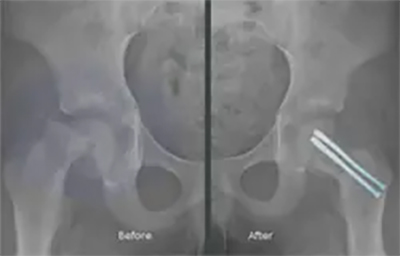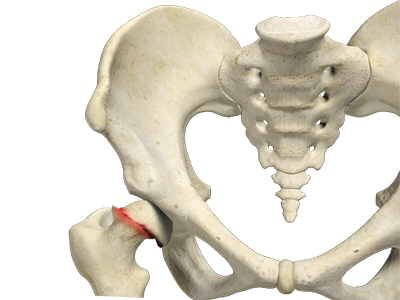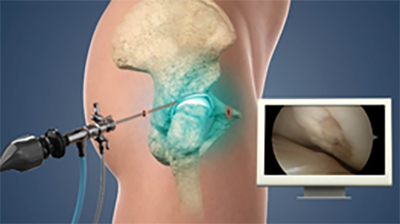Slipped Capital Femoral Epiphysis

What is Slipped Capital Femoral Epiphysis?
Slipped Capital Femoral Epiphysis (SCFE), is a rare condition seen in preadolescents and adolescents. The condition is caused by damage to the femoral growth plate that causes the femoral head to slip out of alignment. SCFE can lead to dysregulation of blood supply to the hip. This condition is observed more frequently in males, kids between 10 and 15 years old, and is usually not associated with trauma or athletic activity.

Causes of Slipped Capital Femoral Epiphysis
SCFE is mainly caused by structural instability of the femoral neck and head when an individual is growing. During the preadolescent and adolescent years, a person will have open growth plates that can be more vulnerable to malformation and the development of SCFE. SCFE can also be confused with other conditions:
- Legg-Calve Perthes Disease
- Osteomyelitis
- Hip dysplasia
- Severe adductor strains
- Femoral or acetabular fractures

Symptoms of Slipped Capital Femoral Epiphysis
- Pain with weight-bearing
- Gradual onset of pain for weeks to several months
- Pain that worsens when standing
- Preference to sit with the affected leg cross over the other leg

Diagnosis of Slipped Capital Femoral Epiphysis
Hip pain can have several causes in younger populations. SCFE requires a variety of tests to be diagnosed. Your doctor will carefully review your symptoms and medical history and perform a physical examination. Diagnostic tests for SCFE include:
- MRI Scan: This study uses a large magnetic field and radio waves to produce images that help detect damage to soft tissue, muscles, tendons, and ligaments located in the hip, thigh, and knee.
- CT Scan: This scan uses multiple X-rays to produce detailed cross-section images of soft tissues, bone, and cartilage structures.
- X-rays: This study uses electromagnetic beams to identify the presence of stress fractures or bony deformities.
- Ultrasound: This study uses high-frequency sound waves to produce images of the tissues.
- Bone scan: This study uses a radioactive substance to detect any damage to the bones.

Treatment for Slipped Capital Femoral Epiphysis
Treatment for SCFE varies based on age, health, type of damage, and the patient's function. Your doctor may initially recommend conservative treatment to help relieve symptoms. This may be sufficient for mild cases of SCFE.

Conservative Treatments
- Anti-Inflammatory Medication: Your doctor may recommend non-steroidal anti-inflammatory drugs (NSAIDs) to reduce pain and inflammation in the tissues.
- Rest and Activity Modification: Reducing or modifying physical activity can help the bones involved with SCFE to heal.
- Physical Therapy: After a rest period, exercises are recommended to address muscle imbalances that may be developed with SCFE.
- Weight Bearing Modifications: If the hip pain is moderate to severe while walking or standing, the patient may be instructed to use crutches and limit weight bearing on the hip for several weeks.

Surgical treatment
If conservative treatment methods are ineffective, and if the patient and physician feel necessary, surgical methods can be recommended. There are two general surgical scenarios for treating SCFE, acute or chronic presentations of SCFE:
Acute SCFE is when the condition is diagnosed earlier in development and can be corrected with:
- Closed reduction and internal fixation with percutaneous screw placement in the proximal femur
- Open reduction Internal Fixation
Chronic SCFE is when the condition presents further along in the development of the patient's hip and can be treated with:
Depending on the procedure and patient-specific factors, rehabilitation can take several weeks to several months.
Persistent pain following surgery may require additional procedures, biotherapeutic injections, or physical therapy.
Meet Experts in Subspine Impingement at the American Hip Institute:
If you think you are suffering from any of the symptoms mentioned above, you may be experiencing SCFE. Experts from the American Hip Institute can provide personalized treatment plans that address your individual needs. Our team uses cutting-edge therapies to diagnose and resolve hip injuries quickly so you can get back on your feet in no time. Contact us today to schedule a consultation.
